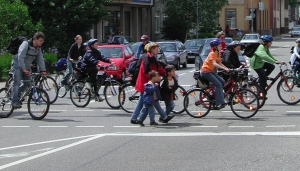An own car or car sharing? Going to work by bicycle? Flying at low costs or using the new long-distance busses? The mobility behavior is changing: On behalf of the Federal Ministry of Transport, Building, and Urban Development (BMVBS), researchers of Karlsruhe Institute of Technology (KIT) have been evaluating the corresponding data of about 2,000 persons in Germany annually for 18 years now. Current findings reveal that people increasingly use different means of transportation. Young people possess an own car less often than senior citizens. The bicycle as a means of transportation is gaining popularity.
“On the one hand, mobility in Germany is determined by demographic developments. On the other hand, the behavior is changing,“ says Dr. Bastian Chlond from the Institute for Transport Studies (IfV) of KIT. Senior citizens, for instance, increasingly have a car, while changes can hardly be noticed in the group of persons able to work up to 65 years of age. “Most of the persons that are now going into retirement had a car during their working life. During retirement, they continue to use their car and gradually replace the generation of senior citizens who were ‘socialized’ without a car,” Chlond explains. In 2011, nearly three quarters (73%) of persons above 60 years of age had a driving license and access to a car in their household. In 2002, these persons had a share of 61% only. According to the study, this process was initially driven by males, but is presently being dominated by females. Young people less often possess an own car.
Another result: Mobility of the Germans increasingly is multi-modal. This means that different transportation means are used depending on the destination and purpose. Among them are the bicycle, public transport means, and the car. “All in all, a certain stability is observed. But this observation is misleading, as certain groups of persons or age groups are subject to considerable changes,” emphasizes Professor Peter Vortisch, Head of the IfV. “Sometimes, the developments go in opposite directions. This is of particular interest when we want to find out which of them will predominate in the long term.” For example, the increasing number of senior citizens possessing a car is opposed to a trend observed for people aged from 18 to 35: The number of persons having access to a car in their household decreased from 83% in 2002 to 74% now.
The bicycle is gaining popularity. Presently, about one third of the Germans are using the bicycle on a weekly basis. The share of paths covered by bicycle increased from about 10% in 2002 to presently nearly 15%. “Long-term observation and analysis of the mobility behavior reveals an increasing use of the bicycle as a means of transportation. This relieves the burden on the cities. It is not only the percentage of persons using the bicycle that is increasing, but also bicycle use is intensified,” Chlond says.
The German Mobility Panel (MOP) measures the mobility of people in Germany and, thus, identifies major trends for planning by the federation, municipalities, and industry. The Mobility Panel was conceived by KIT scientists in the early 1990s. Since then, the data have been evaluated annually on behalf of the Federal Ministry of Transport, Building, and Urban Development (BMVBS). Every year, about 2,000 persons are reporting their mobility behavior. For a period of one week, all persons of the representative households selected are to indicate which means of transportation are used for which path. In addition, they document car use, which means that they report the number of kilometers driven with the own car over a period of eight weeks and their fuel consumption. As the participants report these data over periods of up to three years, trends can be derived.
The German Mobility Panel provides data from 18 years of research. These data may be obtained from the clearing office of the German Aerospace Center (DLR) and can also be used by other researchers or institutions.
More information on the Mobility Panel:
www.mobilitaetspanel.de
The Mobility Systems Center pools KIT activities relating to vehicle technology. Presently, 40 KIT institutes with about 800 employees are working on methodological and technical fundamentals for tomorrow’s vehicles. It is their objective to develop concepts, technologies, methods, and processes for future mobility considering the complex interactions of vehicle, driver, traffic, infrastructure, and society.
Being “The Research University in the Helmholtz Association”, KIT creates and imparts knowledge for the society and the environment. It is the objective to make significant contributions to the global challenges in the fields of energy, mobility, and information. For this, about 10,000 employees cooperate in a broad range of disciplines in natural sciences, engineering sciences, economics, and the humanities and social sciences. KIT prepares its 22,800 students for responsible tasks in society, industry, and science by offering research-based study programs. Innovation efforts at KIT build a bridge between important scientific findings and their application for the benefit of society, economic prosperity, and the preservation of our natural basis of life. KIT is one of the German universities of excellence.

